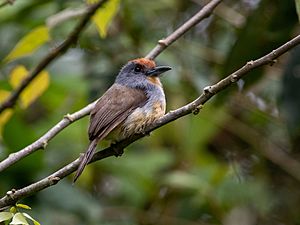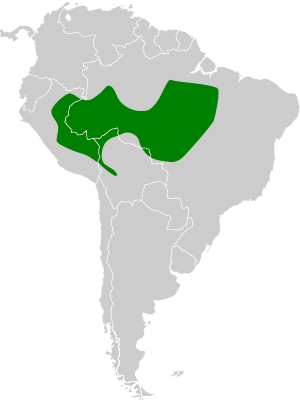Rufous-capped nunlet facts for kids
Quick facts for kids Rufous-capped nunlet |
|
|---|---|
 |
|
| Conservation status | |
| Scientific classification | |
| Genus: |
Nonnula
|
| Species: |
ruficapilla
|
 |
|
The rufous-capped nunlet (Nonnula ruficapilla) is a small, quiet bird found in the forests of South America. It belongs to a family of birds called Bucconidae, which includes puffbirds, nunlets, and nunbirds. These birds are known for often sitting very still, almost like they are waiting. You can find the rufous-capped nunlet in countries like Bolivia, Brazil, and Peru. Its name comes from the reddish-brown "cap" of feathers on its head.
Contents
About the Rufous-Capped Nunlet Family
Birds are grouped into families, and the rufous-capped nunlet is part of the Bucconidae family. This family includes puffbirds, nunlets, and nunbirds. Scientists have identified four main types, or subspecies, of the rufous-capped nunlet. They are slightly different depending on where they live.
- N. r. rufipectus
- N. r. ruficapilla
- N. r. inundata
- N. r. nattereri
Sometimes, scientists think certain nunlets might be the same species. For example, the grey-cheeked nunlet and brown nunlet have been considered very similar to the rufous-capped nunlet. The rufous-capped, grey-cheeked, and chestnut-headed nunlets are also grouped as a "superspecies." This means they are very closely related and likely share a common ancestor.
What Does the Rufous-Capped Nunlet Look Like?
The rufous-capped nunlet is about 14 centimeters (5.5 inches) long. It weighs between 14 and 22 grams (0.5 to 0.8 ounces). The main type of rufous-capped nunlet has a large, rich chestnut-colored cap on its head. The rest of its face, the back of its neck, and the sides of its chest are a cool gray color. Its upper body is a plain dull brown with some reddish parts. The bird's chin and chest are a reddish-orange. Its sides are a lighter reddish color, and the middle of its belly is whitish. Its beak is mostly a shiny silvery-blue. It has brown eyes with a bare reddish ring around them. Its feet are a dark brownish-gray. Other types of rufous-capped nunlets have slightly different colors. For example, N. r. rufipectus has a darker cap and a brighter chest.
Where Do Rufous-Capped Nunlets Live?
The different types of rufous-capped nunlets live in specific areas:
- N. r. rufipectus lives in northeastern Peru.
- N. r. ruficapilla lives in eastern Peru and western Brazil, south of the Amazon River.
- N. r. inundata lives along the Tocantins River in eastern Pará, Brazil.
- N. r. nattereri lives in northern Bolivia and in Brazil's Mato Grosso and western Pará states.
These birds live in the lower parts of forests, often in areas with thick plants. They can be found in different kinds of forests, including those along rivers and streams. They especially like areas with bamboo, particularly thick patches near river edges. In hilly forest areas, they are often found near streams.
Behavior and Habits
What Do Rufous-Capped Nunlets Eat?
Scientists have found insect remains in the stomachs of rufous-capped nunlets. This tells us that they eat insects. However, not much else is known about what they eat or how they find their food.
Reproduction and Life Cycle
Very little is known about how rufous-capped nunlets reproduce or their breeding habits. Scientists are still learning about this part of their life cycle.
What Does the Rufous-Capped Nunlet Sound Like?
The song of the rufous-capped nunlet is a long series of sharp, clear whistles. It can have between 13 and 30 notes. The sound is often described as "fwick!-fwick!". The song starts and ends a little softer and lower in pitch.
Conservation Status
The IUCN (International Union for Conservation of Nature) has assessed the rufous-capped nunlet as being of "Least Concern." This means that it is not currently considered to be in danger of extinction. Even though it lives across a very large area, its total population is not known. However, scientists believe that the number of these birds might be decreasing. It is fairly common in Brazil, but less common in Peru, and uncommon to rare in Bolivia.
See also
 In Spanish: Monjilla coronada para niños
In Spanish: Monjilla coronada para niños


